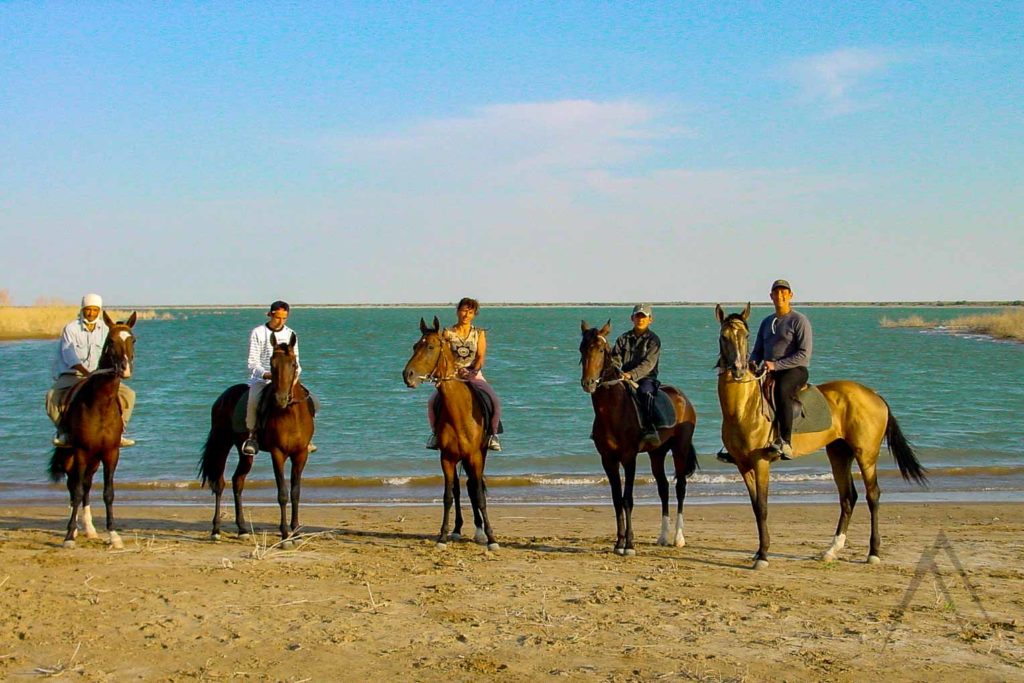Akhal Teke
Akhal-Teke horse
Akhal-Teke (or Ahal teke) is a famous horse breed admired for its speed, intelligence and strength in long hikes and is also the pride of all Turkmen. Akhal Teke horses have been honored in Turkmen’s traditional songs, proverbs and poems and their intellect, wisdom and devotion to human beings are all legendary. One Turkmen proverb says, “When you get up in the morning you must greet your father and your horse”. The Akhal-Teke horses are relatively tall and slender in shape, with a long, lean body and a narrow, refined head. Its legs are also long and slender and it has a long, flowing tail. The breed comes in a variety of colors, including black, chestnut, bay, gray, and palomino but its most distinctive feature is the metallic sheen formed by the specific structure of their hair.
This remarkable breed of horses has a nearly 3000-year history and is believed being one of the most ancient horse breeds. These so-called “golden horses” are adapted to the harsh climatic conditions of the Central Asian deserts. The Akhal Teke breed was first developed in the Kara Kum Desert, Turkmenistan, which is a rocky area surrounded by mountains that played a vital role in maintaining the purity of the breed. The Turkmen Kurds first utilized horses for warfare and then started breeding and valued them for their speed and quickness. The story of this horse has spread as a word of mouth by the Turkmen tribes and there are no written records to prove it. It is believed that Alexander the Macedonian’s (Alexander the Great) horse, Bucephalus, was of the Akhal-Teke breed.
After the Bolshevik Revolution, the Akhal Teke horses experienced a tough period in their history. During collectivization efforts, all Akhal Teke horses were registered with the new Soviet government and private ownership of horses was banned. By the end of the 20th century, this ancient and unique horse breed was in danger of extinction. Today there are about 6600 Akhal-Tekes in the world, mainly in Turkmenistan, Russia and also throughout Europe and North America.


The Akhal Teke breed got its name from the Russian general Kuropatkin, who admired the horses during the battle with the Turkmen and after the war called them Akhal-Teke. The general took the name from the Teke tribe inhabiting the Ahal oasis, the southern part of the Aral-Caspian along the north slope of the Kopet Dag mountains. Ahal Teke horses became one of the most striking models of talent and mastery of the Turkmen people. Perhaps, therefore Turkmen are very proud of their horses.
The origin of Akhal Teke horses stretches back to ancient times. Chinese called them “Heavenly horses” or Divine Horses. Ancient Greek, Roman, Chinese and Arab chronicles mention the desires to obtain one of these superior horses, including the chronicles of King Cyrus of Persia, Alexander the Great and various Chinese emperors and Arab rulers.
Turkmen horse-breeders had a particular approach to their horses. Each Turkmen kept one horse and fed them grains of food that contained a mixture of alfalfa, barley and mutton fat. Historians noted that “The Turkmen do not only nourish gently their horses but also do it with passion. To treat a horse badly was considered a crime among them. The whole tribe would scorn a person committing such a sin.” For this reason, of all Central Asian peoples, Turkmen are the only ones who never slaughter a horse for its meat or drink mare’s milk.


The Akhal Teke is a great sport horse and perfect in marathon racing; dressage, breaking in and flat race conquer. In 1935, thirty Turkmen riders with their horses made a pretty long trek and covered 4300 km from Ashgabat to Moscow in 84 days. All horses successfully survived the difficulties of this trek, the major part of which runs through the Karakum and other desert terrains.
Shortly afterward the Akhal Teke horse Zenith set a record by covering 300 km in 19 hours. The Akhal Teke has therefore demonstrated itself as a horse of endurance and if necessary the Ahal Teke can stay without food and water for much longer than other horses and can easily endure desert terrible heat.

See Ahal Teke horse in Turkmenistan
Page updated 28.3.2021
